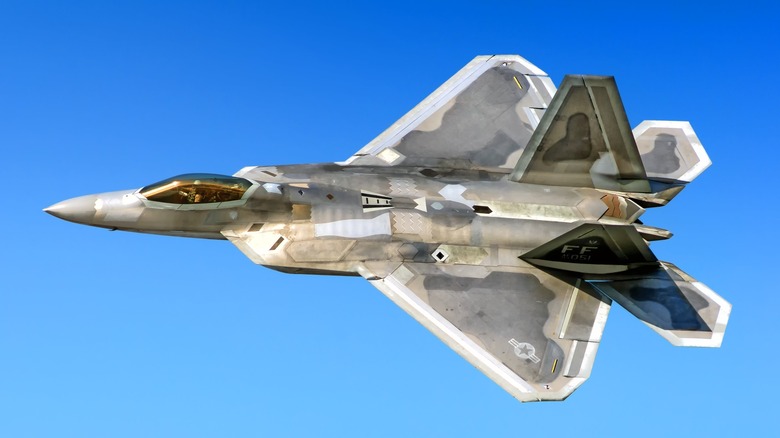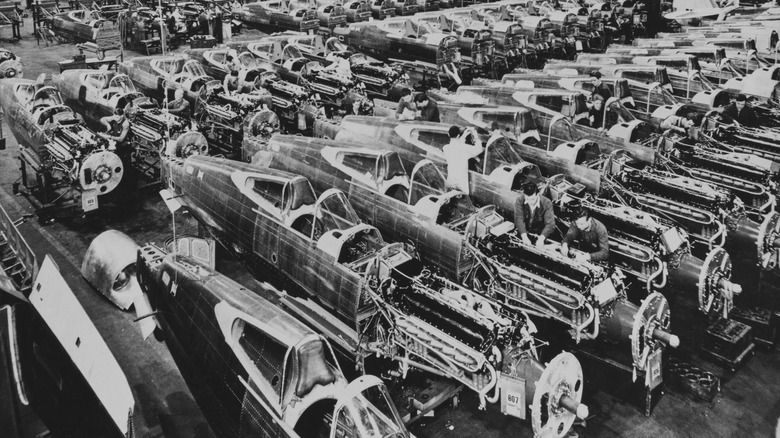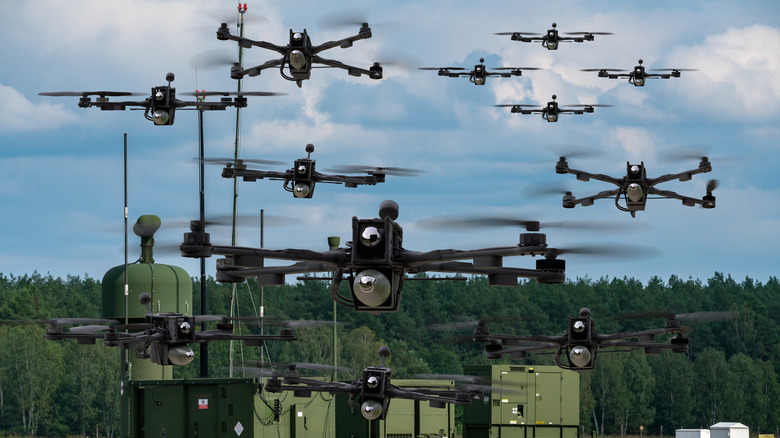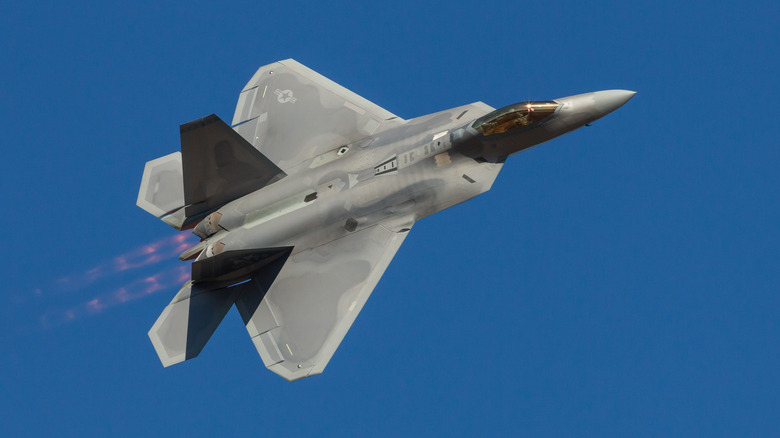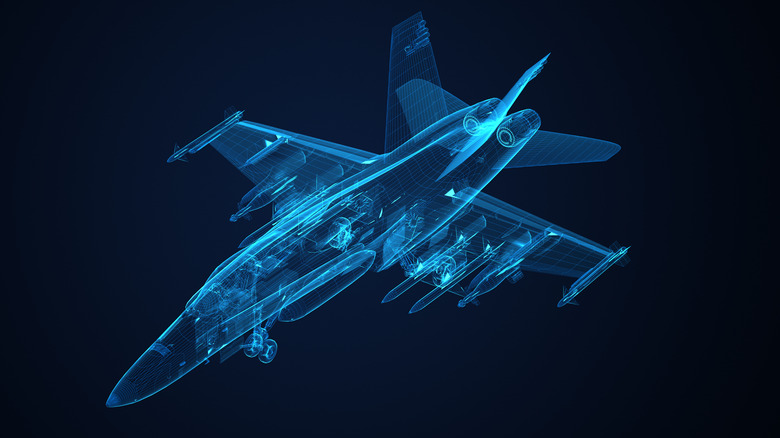Everything We Know About The Next Generation Of U.S Fighter Jets
Next-generation technology is all the rage. Whether you're talking about gaming, smartphone improvements, or the United States military's arsenal, new and improved gear just seems to make life better. As of now, only three countries have introduced what has come to be known as a fifth-generation fighter jet. Russia's Su-57, China's J-20, and the United States F-22 and F-35 have all earned this moniker. These new jets dominate the skies when compared to older aerial fighters, as even the U.S.'s technically dazzling F-16, which is lighter than the F-22 and one of the most maneuverable planes ever built, couldn't take the heat if matched up against the newer jet in a dogfight. After all, the U.S. Air Force claims that "the F-22 cannot be matched by any known or projected fighter aircraft."
Even these superior air combat tools stand ready to be outmaneuvered by what will eventually come next. While most nations on the planet retain fourth-generation aircraft or seek to purchase these newer models from the countries that make them for their own air force, the United States is already eying a redesign that will see its air superiority reach into the sixth generation of fighter jet. Details remain somewhat sparse, but from what is already out there in the ether, these new weapons platforms will dwarf the aerial readiness that existing jets have come to establish for the United States armed forces.
Modular design characteristics
The first change that new fighter jets will experience is a modular redesign. Instead of relying on the same chassis development tactics that have underpinned previous aircraft, these new sixth-generation fighters will be totally modular. This means that weapons system upgrades, component exchanges, and routine improvements to help maintain the longevity of individual aircraft and the viability of the fleet for overall mission success will be built into the new fighter jets from the moment they leave the assembly facility.
Modular design will allow the jets to evolve alongside continuously changing technology. The B-21 Raider, for instance, was unveiled in December 2022, marking the U.S. military's first foray into sixth-generation aircraft design. The bomber will likely eventually take over the duties of the B-2 bomber that's been in service for more than three decades. It's built to feature adaptability as a key component of the aircraft's design. Lloyd Austin, the U.S. Secretary of Defense, noted at Northrup Grumman's Palmdale plant that the bomber will be capable of carrying and utilizing weapons that have yet to be invented.
This is perhaps the core of sixth-generation aerial technology — wide-ranging utility that stands ready to integrate cutting-edge innovations without hesitation.
Drone integration
Uncrewed vessels remain a highly prized component of any military fleet. Since their earliest development, researchers and practitioners have pointed to the safety a drone fleet provides to the human operators standing behind them. One area that has already seen enormous innovation is in naval drone ships — most notably in the Chinese Navy, which has deployed several experimental crewless vessels.
However, AI and other autonomous systems have made their way into the aerial combat space as well. With sixth-generation fighters in the skies, it appears that pilots will be accompanied into hostile territory with an accompanying drone swarm that adds to the firepower available while improving operational security for pilots undertaking these missions. The Air Force has already begun work on UAVs that carry and deploy swarms of smaller, flight-capable, and autonomous assets.
In the future, these drone swarms are slated to take on electronic warfare, bombing, and wingman roles to assist more capable sixth-generation aircraft. This innovation will alter the landscape of aerial combat forever.
Even more advanced stealth qualities
Stealth technology is another feature that stands front and center when discussing the advancements made to existing or proposed military vessels. This is true for fighter jets, just as it is for tanks, ships, and virtually all other vehicles that service members rely on to get the job done.
With a new generation of fighters in development, integrated stealth technologies will play a central role in creating an even more agile and difficult-to-detect vessel that maintains superiority over its adversaries across hostile skies. A feature already being discussed is a novel composite material that will serve as the building block of these jets' construction. Any talk of new building materials on a plane immediately evokes two potential pursuits — agility and stealth.
Shedding weight from the fuselage is always essential, and designers have continued to make improvements in this area. However, the introduction of new stealth shielding to further hide these aircraft from radar detection is what will set them truly apart from others on the battlefield.
They will cost a lot!
The U.S. Air Force and Navy both have sixth-generation aircraft in the works already. They are both dubbed Next Generation Air Dominance (NGAD) in their current state, and neither project is particularly out there in the spotlight. The undertaking to create a sixth-generation fighter is, however, more comprehensive than just building a new aircraft.
The jump from generation to generation requires a massive undertaking to redesign everything about the way military flight is produced. This takes money — a lot of it! Designing and building F-35s for the U.S. military (a fifth-generation fighter) cost an estimated $412 billion. On top of this price tag, the Pentagon projects an additional $1.3 trillion to maintain and operate the fleet.
At the very least, redesigning the aerial capabilities of the United States military once more will likely cost just as much. Still, investment in these kinds of technologies has often been prioritized in the past. They help keep U.S. servicemembers equipped with the best gear on the planet and as safe as possible while engaged in duties that protect Americans at home and abroad.
